Student Mobility between Charter and Traditional Public School Sectors: Assessing Enrollment Patterns among Major Charter Management Organizations in Texas
Abstract
1. Introduction
2. Literature Review
2.1. Research on the Charter School Sector in the U.S.
2.2. Research on the Charter School Sector in Texas
3. Enrollment in Charter Schools in Texas
4. Theoretical Framework
5. Data and Methods
5.1. Data
5.2. Analytic Approach
6. Findings
6.1. Special Education
6.2. Prior Achievement in Grades 3 to 8
6.3. Other Student Characteristics
7. Discussions
7.1. Synthesizing Results
7.2. Limitations
7.3. Future Research Directions
8. Conclusions
Author Contributions
Funding
Data Availability Statement
Conflicts of Interest
References
- National Center for Education Statistics. Digest of Education Statistics, 2020: Table 105.30., Enrollment in Elementary, Secondary, and Degree-Granting Postsecondary Institutions, by Level and Control of Institution: Selected Years, 1869–1870 through Fall 2029; Washington, DC, USA. 2021. Available online: https://nces.ed.gov/programs/digest/d20/tables/dt20_105.30.asp (accessed on 1 December 2021).
- Baker, B.D.; Dickerson, J.L. Charter schools, teacher labor market deregulation, and teacher quality: Evidence from the schools and staffing survey. Educ. Policy 2006, 20, 752–778. [Google Scholar] [CrossRef]
- Mungal, A.S. Teach for America, Relay Graduate School, and the charter school networks: The making of a parallel education structure. Educ. Policy Anal. Arch. 2016, 24, 1–30. [Google Scholar] [CrossRef][Green Version]
- Arsen, D.; DeLuca, T. Which districts get into financial trouble and why: Michigan’s story. J. Educ. Financ. 2016, 45, 100–126. [Google Scholar]
- Bruno, P. Charter competition and district finances: Evidence from California. J. Educ. Financ. 2019, 44, 361–384. [Google Scholar]
- Mann, B.A.; Bruno, P. The effects of charter school enrollment losses and tuition reimbursements on school districts: Lifting boats or sinking them? Educ. Policy 2022, 36, 1078–1107. [Google Scholar] [CrossRef]
- Kolbe, T.; Dhuey, E.; Doutre, S.M. More money is not enough: (Re) considering policy proposals to increase federal funding for special education. Am. J. Educ. 2022, 129, 1086. [Google Scholar] [CrossRef]
- Baker, B.D.; Corcoran, S.P. The stealth inequities of school funding: How state and local school finance systems perpetuate inequitable student spending. Cent. Am. Prog. 2012, 9, 26. [Google Scholar]
- Knight, D.S.; Mendoza, J. Does the measurement matter? Assessing alternate approaches to measuring state school finance equity for California’s Local Control Funding Formula. AERA Open 2019, 5, 2332858419877424. [Google Scholar] [CrossRef]
- Knight, D.S.; Toenjes, L.A. Do charter schools receive their fair share of funding? School finance equity for charter and traditional public schools. Educ. Policy Anal. Arch. 2020, 28, 51. [Google Scholar] [CrossRef]
- Kretchmar, K.; Sondel, B.; Ferrare, J.J. Mapping the terrain: Teach for America, charter school reform, and corporate sponsorship. J. Educ. Policy 2014, 29, 742–759. [Google Scholar] [CrossRef]
- Bergman, P.; McFarlin, I., Jr. Education for All? A Nationwide Audit Study of Schools of Choice; Working Paper; NBER: New York, NY, USA, 2018; Available online: http://www.columbia.edu/~psb2101/BergmanMcFarlin_school_choice.pdf (accessed on 1 December 2021).
- Dee, T.S.; Fu, H. Do charter schools skim students or drain resources? Econ. Educ. Rev. 2004, 23, 259–271. [Google Scholar] [CrossRef]
- Lacireno-Paquet, N.; Holyoke, T.T.; Moser, M.; Henig, J.R. Creaming versus cropping: Charter school enrollment practices in response to market incentives. Educ. Eval. Policy Anal. 2002, 24, 145–158. [Google Scholar] [CrossRef]
- Brighouse, H. School Choice and Social Justice; Oxford University Press: Oxford, UK, 2003. [Google Scholar]
- Hoxby, C.M. The Economics of School Choice; University of Chicago Press: Chicago, IL, USA, 2007. [Google Scholar]
- Chubb, J.E.; Moe, T.M. America’s public schools: Choice is a panacea. Brook. Rev. 1990, 8, 4–12. [Google Scholar] [CrossRef]
- Shanker, A. Restructuring our schools. Peabody J. Educ. 1988, 65, 88–100. [Google Scholar] [CrossRef]
- National Center for Education Statistics. Racial/ethnic Enrollment in Public Schools; National Center for Education Statistics: Washington, DC, USA, 2018. Available online: https://nces.ed.gov/programs/coe/indicator/cge (accessed on 1 December 2021).
- Archibald, D.A. School choice, magnet schools, and the liberation model: An empirical study. Sociol. Educ. 2004, 77, 283. [Google Scholar] [CrossRef]
- Buckley, J.; Schneider, M. Charter Schools: Hope or Hype? Princeton University Press: Princeton, NJ, USA, 2009. [Google Scholar]
- Bifulco, R.; Ladd, H. The impacts of charter schools on student achievement: Evidence from North Carolina. Educ. Financ. Policy 2006, 1, 50–90. [Google Scholar] [CrossRef]
- Buckley, J.; Schneider, M. Are charter school students harder to educate? Evidence from Washington, D.C. Educ. Eval. Policy Anal. 2005, 27, 365–380. [Google Scholar] [CrossRef]
- Gleason, P.; Clark, M.; Tuttle, C.C.; Dwoyer, E. The Evaluation of Charter School Impacts: Final Report; National Center on Education and the Economy: Washington, DC, USA, 2010. [Google Scholar]
- Knight, D.S.; Hassairi, N.; Martínez, D. Segregation and school funding disparities in California: Contemporary trends 50 years after Serrano. BYU Educ. Law J. 2022, 2022, 83–111. [Google Scholar]
- Waitoller, F.R.; Maggin, D.M.; Trzaska, A. A Longitudinal Comparison of Enrollment Patterns of Students Receiving Special Education in Urban Neighborhood and Charter Schools. J. Disabil. Policy Stud. 2017, 28, 3–12. [Google Scholar] [CrossRef]
- Garcy, A.M. High expense: Disability severity and charter school attendance in Arizona. Educ. Policy Anal. Arch. 2011, 19, 1–26. [Google Scholar] [CrossRef][Green Version]
- Chaikind, S.; Danielson, L.C.; Brauen, M.L. What do we know about the costs of special education? A selected review. J. Spec. Educ. 1993, 26, 344–370. [Google Scholar] [CrossRef]
- Chambers, J.G.; Perez, M.; Harr, J.J.; Shkolnik, J.; Esra, P. Special education spending estimates from 1969–2000. J. Spec. Educ. Leadersh. 2005, 18, 5–13. [Google Scholar]
- McMorris, C.; Knight, D.S. How states prioritize educational needs: Assessing the distribution of the Governor’s Emergency Education Relief Fund. J. Educ. 2022, 48, 5–33. [Google Scholar]
- Parrish, T.; Esra, P. The Special Education Expenditure Project (SEEP): Synthesis of findings and policy implications. In Forum, Project Forum; National Association of State Directors of Special Education: Alexandria, VA, USA, 2006; Available online: https://nasdse.org/docs/217_d5fd28bb-dd1f-4b11-abb5-cbdd9e7e1583.pdf (accessed on 1 December 2021).
- Knight, D.S.; Hassairi, N.; Candelaria, C.; Sun, M.; Plecki, M. Prioritizing school finance equity during an economic downturn: Recommendations for state policymakers. Educ. Financ. Policy 2022, 17, 188–199. [Google Scholar] [CrossRef]
- Winters, M.A. Why the Gap? Special Education and New York City Charter Schools; Manhattan Institute for Policy Research, Center for Reinventing Public Education: New York, NY, USA, 2013. [Google Scholar]
- Winters, M.A. Understanding the gap in special education enrollments between charter and traditional public schools: Evidence from Denver, Colorado. Educ. Res. 2015, 44, 228–236. [Google Scholar] [CrossRef]
- Gilmour, A.; Shanks, C.; Winters, M.A. The Effect of Charter Schooling on Student Mobility and Classification Status; Working Paper 2021-6; Wheelock Educational Policy Center, Boston University: Boston, MA, USA, 2021. [Google Scholar]
- Rhim, L.M.; Ahearn, E.; Lange, C.M.; McLaughlin, M.J. Survey of Charter School Authorizers; Report No. 6; Institute for the Study of Exceptional Children and Youth: College Park, MD, USA, 2007. [Google Scholar]
- West, A.; Ingram, D.; Hind, A. “Skimming the cream”: Admissions to charter schools in the United States and to autonomous schools in England. Educ. Policy 2006, 20, 615–639. [Google Scholar] [CrossRef]
- Altonji, J.G.; Huang, C.I.; Taber, C.R. Estimating the cream skimming effect of school choice. J. Political Econ. 2015, 123, 266–324. [Google Scholar] [CrossRef]
- Cordes, S.A. NEPC Review: New York Charter Schools Outperform Traditional Selective Public Schools: More Evidence That Cream-Skimming is Not Driving Charters’ Success. Natl. Educ. Policy Cent. 2017, 5, 11. Available online: https://files.eric.ed.gov/fulltext/ED579511.pdf (accessed on 1 December 2021).
- Zimmer, R.W.; Guarino, C.M. Is there empirical evidence that charter schools “push out” low-performing students? Educ. Eval. Policy Anal. 2013, 35, 461–480. [Google Scholar] [CrossRef]
- Winters, M.A. New York charter schools outperform traditional selective public schools: More evidence that cream-skimming is not driving charters’ success. Manhattan Inst. Policy Res. 2017, 16, 579166. Available online: https://www.manhattan-institute.org/html/new-york-charter-schools-outperformtraditional-selective-public-schools-10128.html (accessed on 1 December 2021).
- Anderson, K.P. Evidence on charter school practices related to student enrollment and retention. J. Sch. Choice 2017, 11, 527–545. [Google Scholar] [CrossRef]
- Texas Education Agency. “Enrollment in Texas Public Schools 2019–20.” Division of Research and Analysis, Office of Governance and Accountability. Available online: https://tea.texas.gov/sites/default/files/enroll_2019–20.pdf (accessed on 1 December 2021).
- Booker, K.; Gilpatric, S.M.; Gronberg, T.; Jansen, D. The effect of charter schools on traditional public school students in Texas: Are children who stay behind left behind? J. Urban Econ. 2008, 64, 123–145. [Google Scholar] [CrossRef]
- Estes, M.B. Choice for all? Charter schools and students with special needs. J. Spec. Educ. 2004, 37, 257–267. [Google Scholar] [CrossRef]
- Booker, K.; Zimmer, R.; Buddin, R. The effect of charter schools on school peer composition. RAND Work. Pap. 2005, 2, 1–38. Available online: http://www.rand.org/pubs/working_papers/WR306.html (accessed on 1 December 2021).
- Zimmer, R.; Gill, B.; Booker, K.; Lavertu, S.; Sass, T.R.; Witte, J. Charter Schools in Eight States: Effects on Achievement, Attainment, Integration, and Competition; Rand Corporation: Santa Monica, CA, USA, 2009; Available online: http://www.rand.org/pubs/monographs/MG869.html (accessed on 1 December 2021).
- Nichols-Barrer, I.; Gleason, P.; Gill, B.; Tuttle, C.C. Student selection, attrition, and replacement in KIPP middle schools. Educ. Eval. Policy Anal. 2016, 38, 5–20. [Google Scholar] [CrossRef]
- Angrist, J.D.; Dynarski, S.M.; Kane, T.J.; Pathak, P.A.; Walters, C.R. Who benefits from KIPP? J. Policy Anal. Manag. 2012, 31, 837–860. [Google Scholar] [CrossRef]
- Gleason, P.; Tuttle, C.; Gill, B.; Nichols-Barrer, I.; Teh, B. Do KIPP schools boost student achievement? Educ. Financ. Policy 2014, 9, 36–58. [Google Scholar] [CrossRef]
- Knight, D.S.; Karcher, H.; Hoang, T. School finance equity through accountability? Exploring the role of federal oversight of school districts under the Every Student Succeeds Act. Peabody J. Educ. 2022, 97, 458–478. [Google Scholar] [CrossRef]
- Baude, P.L.; Casey, M.; Hanushek, E.A.; Phelan, G.R.; Rivkin, S.G. The evolution of charter school quality. Economica 2020, 87, 158–189. [Google Scholar] [CrossRef]
- Nickson, D. Embracing the city: Black Families’ place attachments and (Re) imaginings of the city and suburb in search of educational opportunity. AERA Open 2022, 8, 1–14. [Google Scholar] [CrossRef]
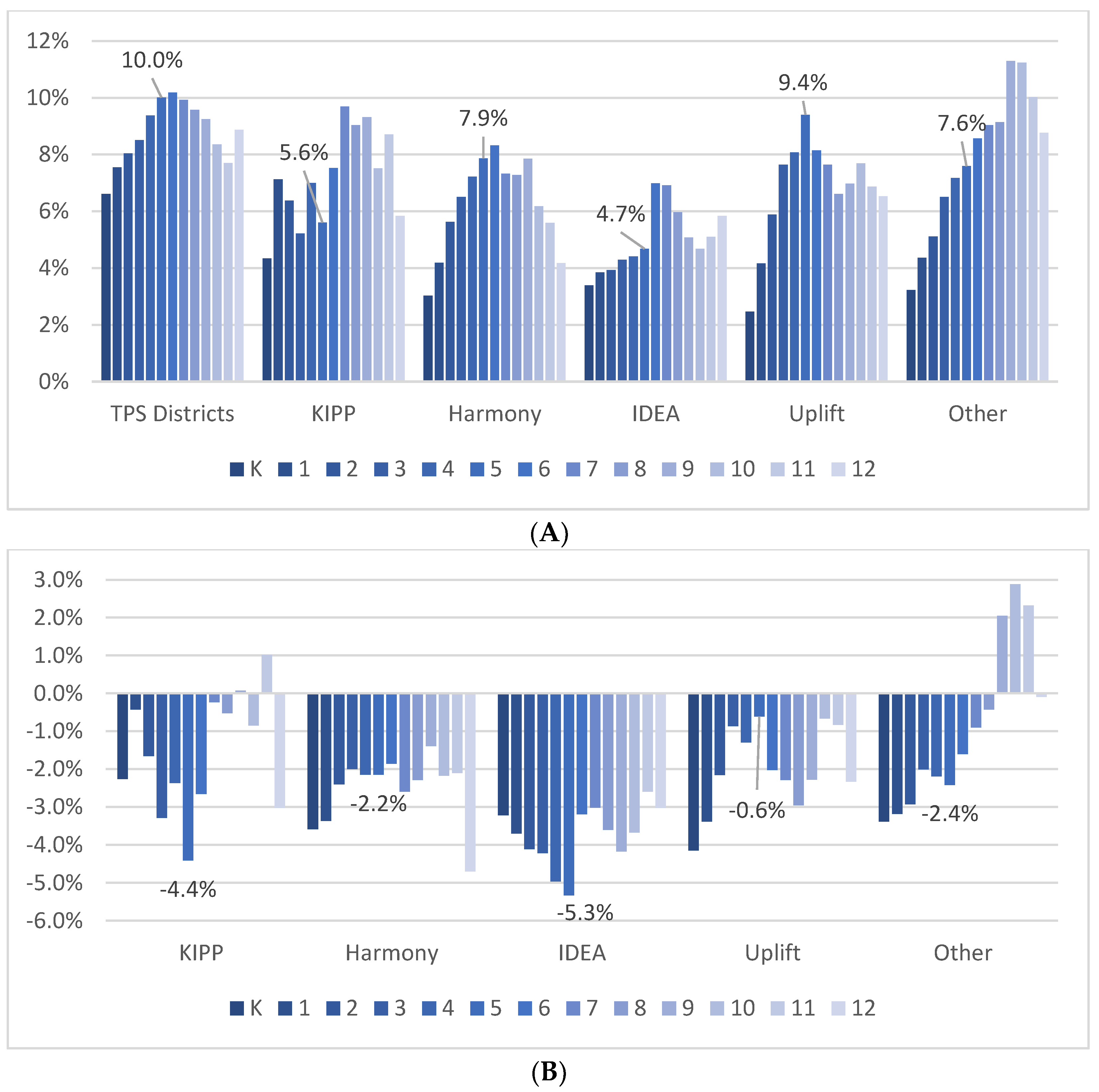
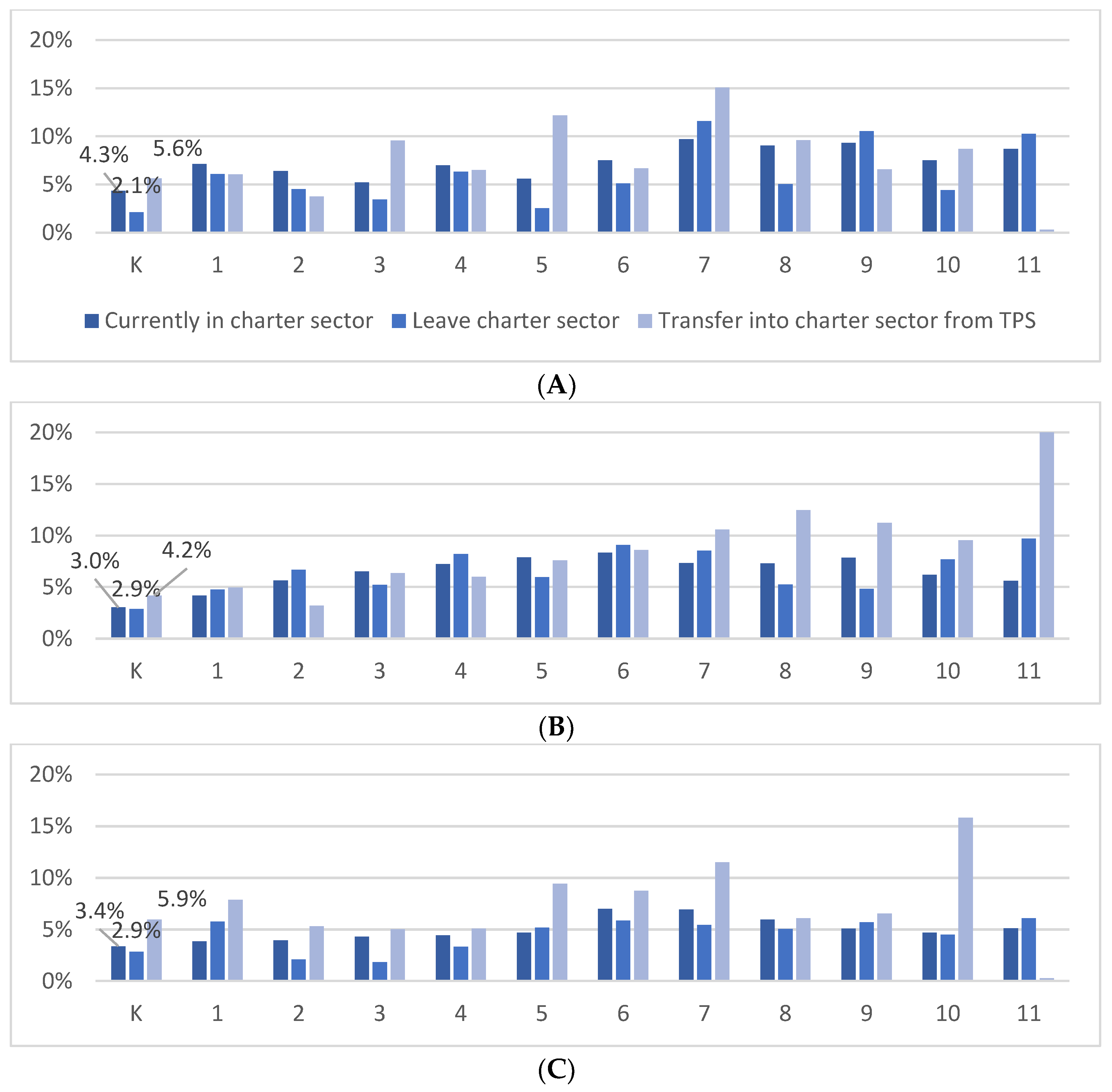
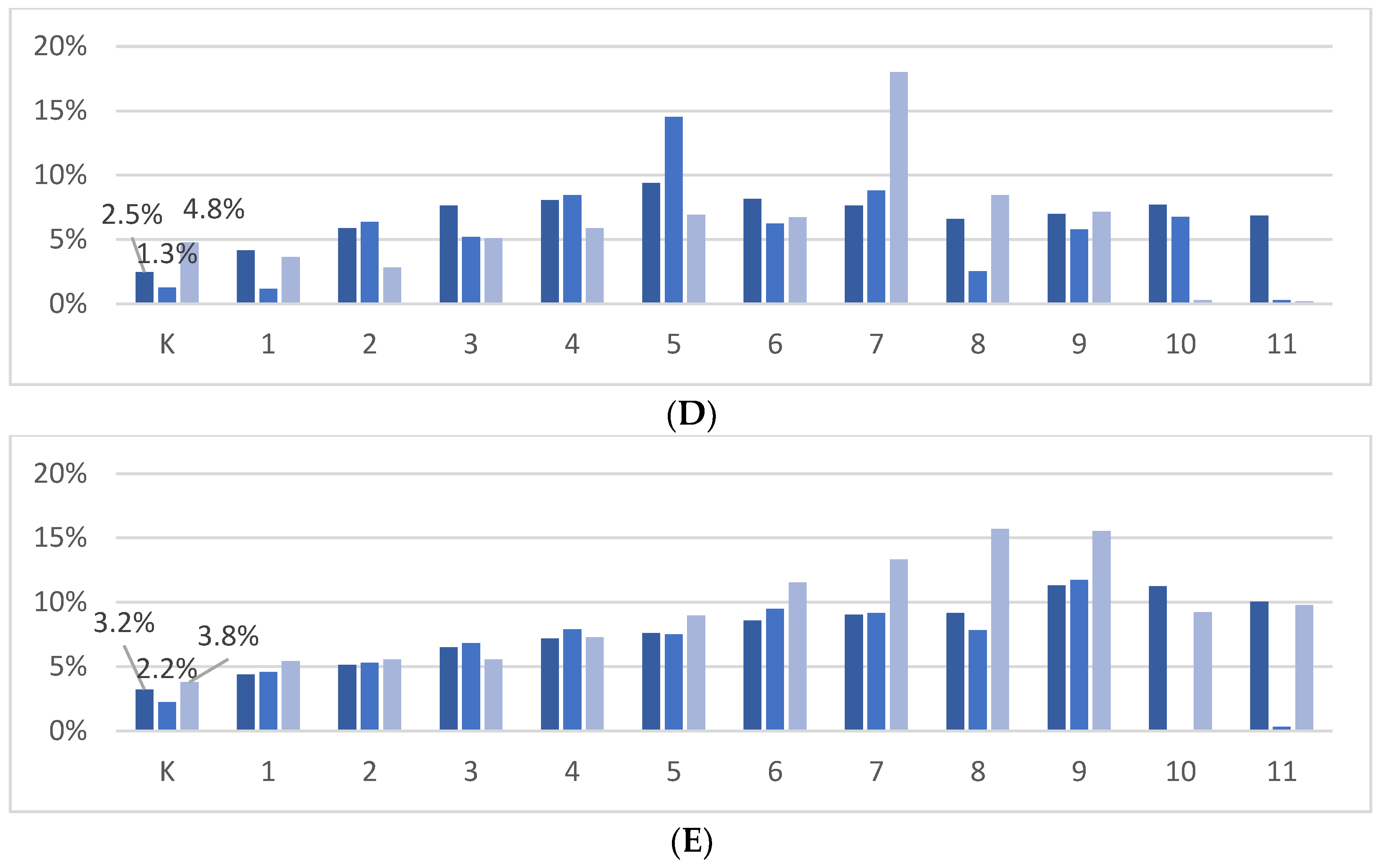

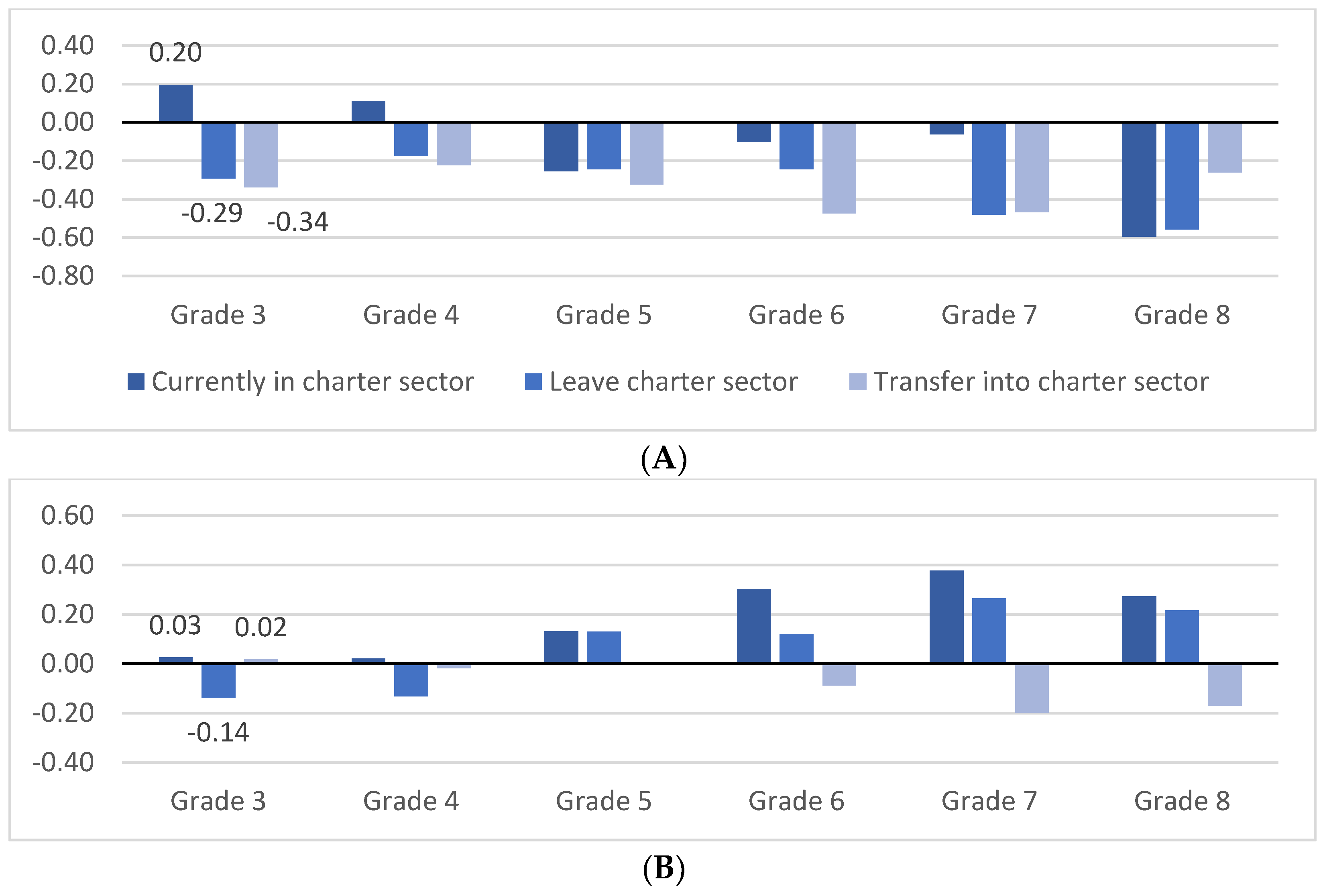

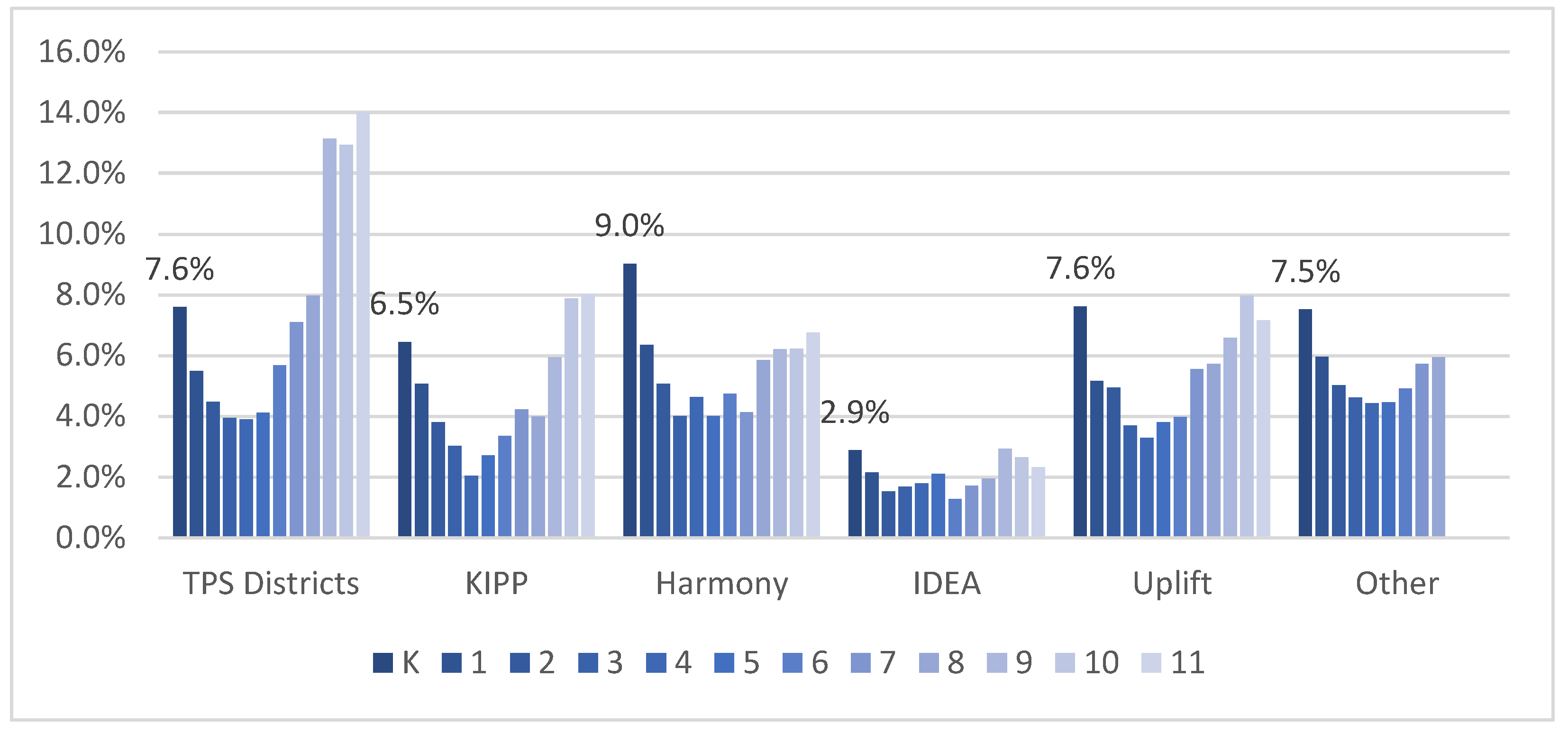
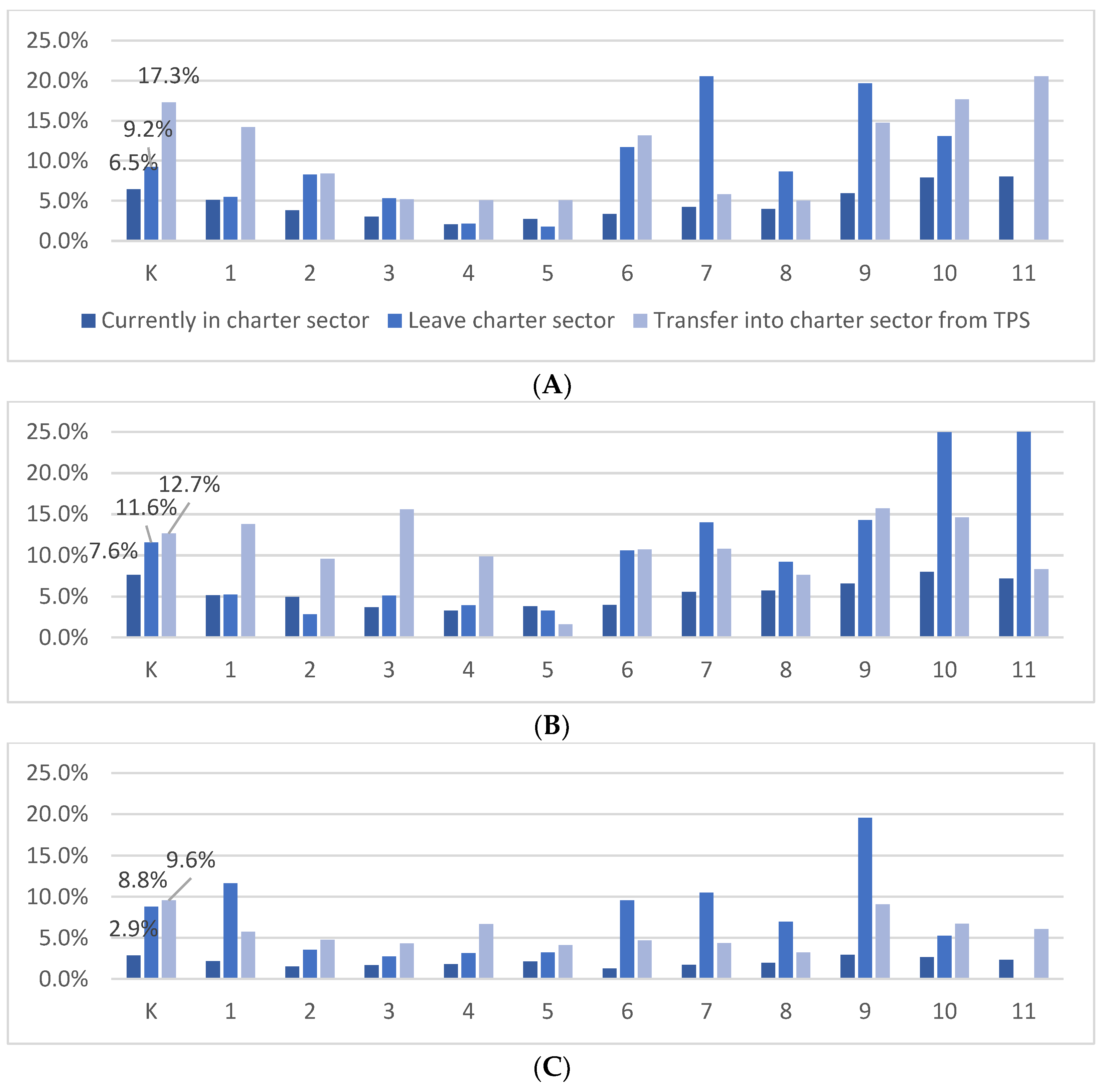
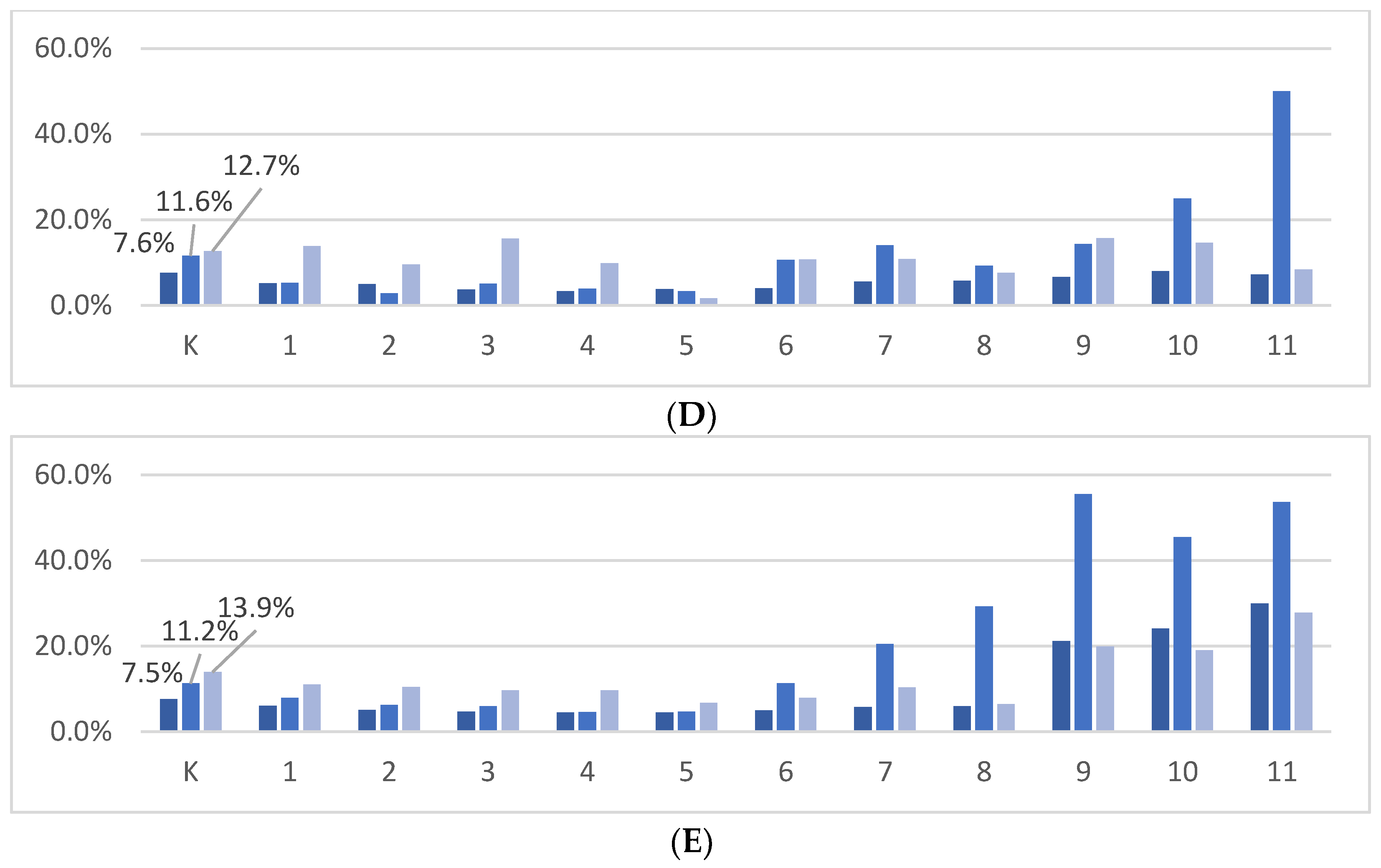
| 2016–17 School Year | 2017–18 Enrollment | % Incr. from 2016–17 | ||||
|---|---|---|---|---|---|---|
| Districts | Schools | Enrollment | Percent of All Charters | |||
| A. Charter districts | ||||||
| Harmony | 7 | 46 | 31,985 | 11.7% | 33,248 | 3.9% |
| IDEA | 1 | 44 | 29,334 | 10.8% | 35,595 | 21.3% |
| KIPP | 4 | 41 | 23,279 | 8.5% | 25,154 | 8.1% |
| Uplift | 1 | 29 | 15,768 | 5.8% | 17,291 | 9.7% |
| Sub Total (largest four charters) | 13 | 160 | 100,366 | 36.8% | 111,288 | 10.9% |
| All other charters | 167 | 469 | 172,319 | 63.2% | 184,925 | 7.3% |
| Sub Total (largest four + all other charters) | 180 | 629 | 272,685 | 100.0% | 296,213 | 8.6% |
| B. Traditional public school (TPS) districts | ||||||
| All TPS districts | 1023 | 8082 | 5,071,149 | 5,088,799 | 0.3% | |
| Total | 1216 | 9180 | 5,343,834 | 5,385,012 | 0.8% | |
Publisher’s Note: MDPI stays neutral with regard to jurisdictional claims in published maps and institutional affiliations. |
© 2022 by the authors. Licensee MDPI, Basel, Switzerland. This article is an open access article distributed under the terms and conditions of the Creative Commons Attribution (CC BY) license (https://creativecommons.org/licenses/by/4.0/).
Share and Cite
Knight, D.S.; Shin, J.; McMorris, C. Student Mobility between Charter and Traditional Public School Sectors: Assessing Enrollment Patterns among Major Charter Management Organizations in Texas. Educ. Sci. 2022, 12, 915. https://doi.org/10.3390/educsci12120915
Knight DS, Shin J, McMorris C. Student Mobility between Charter and Traditional Public School Sectors: Assessing Enrollment Patterns among Major Charter Management Organizations in Texas. Education Sciences. 2022; 12(12):915. https://doi.org/10.3390/educsci12120915
Chicago/Turabian StyleKnight, David S., Jinseok Shin, and Claire McMorris. 2022. "Student Mobility between Charter and Traditional Public School Sectors: Assessing Enrollment Patterns among Major Charter Management Organizations in Texas" Education Sciences 12, no. 12: 915. https://doi.org/10.3390/educsci12120915
APA StyleKnight, D. S., Shin, J., & McMorris, C. (2022). Student Mobility between Charter and Traditional Public School Sectors: Assessing Enrollment Patterns among Major Charter Management Organizations in Texas. Education Sciences, 12(12), 915. https://doi.org/10.3390/educsci12120915






